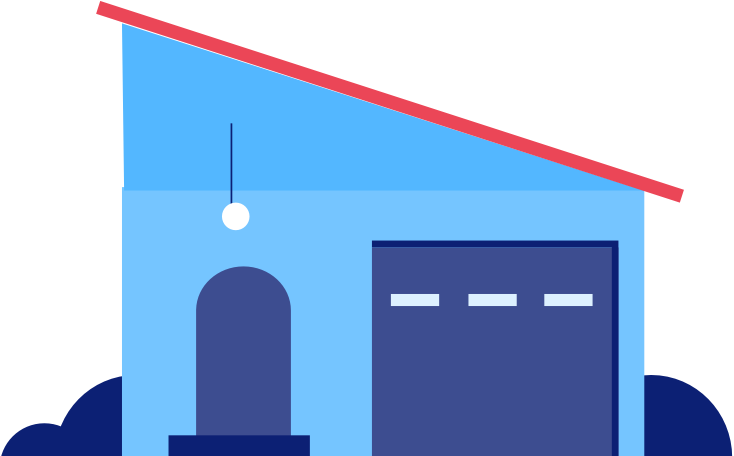
There are many costs to factor in when you’re shopping for a home. One of the most important? The down payment. Let’s go over minimum down payments on mortgages, what percentage you may want to save to feel confident going into the mortgage process and some common down payment myths.
Down payment: 101
A down payment is a portion of the cost of a home, that you pay up front. It represents your initial investment in your home. When you put more money down, you're taking some of the risk away from the lender – proof that you’re invested in the purchase and a sign that you’re committed to making all your mortgage payments. In return, the lender may offer you a lower mortgage interest rate.

Mortgage loan snapshot
Quickly get a free, no-credit-hitting estimate of how much you could borrow.
Do you have to put 20% down on a house?
No, in fact the median down payment for first-time home buyers in 2021 was just 6% according to the National Association of Realtors.1 You may have heard that a down payment should be 20% of a home’s purchase price, and while it does have advantages, it’s not necessary.
A Federal Housing Administration (FHA) Mortgage has a minimum down payment of only 3.5%. It’s available to all qualified buyers, regardless of income level. Also, you can buy a home with no down payment if you meet the specific restrictions of a United States Department of Agriculture (USDA) loan or a Veteran Affairs (VA) loan.
Minimum down payments on mortgages
|
Mortgage type |
Minimum down payment |
Other restrictions? |
|---|---|---|
|
Adjustable-rate mortgages (ARM) |
10% |
The loan limit varies by region. |
|
Jumbo loans |
10% |
Loan amounts up to $3,000,000. For loan limits above conforming loan limits, it’s currently set at $806,500. |
|
Conventional fixed-rate loans |
5% |
The loan limit varies by region but is generally set at $806,500. |
|
FHA loans |
3.5% |
The maximum home price in most areas is $524,225 but can be as much as $1,209,750 where home prices are higher. |
|
VA loans |
0% |
Borrower must be a Military Service Veteran, currently active military service personnel or a surviving spouse. |
Mortgage type
Adjustable-rate mortgages (ARM)
Minimum down payment
10%
Other restrictions?
The loan limit varies by region.
Mortgage type
Jumbo loans
Minimum down payment
10%
Other restrictions?
Loan amounts up to $3,000,000. For loan limits above conforming loan limits, it’s currently set at $806,500.
Mortgage type
Conventional fixed-rate loans
Minimum down payment
5%
Other restrictions?
The loan limit varies by region but is generally set at $806,500.
Mortgage type
FHA loans
Minimum down payment
3.5%
Other restrictions?
The maximum home price in most areas is $524,225 but can be as much as $1,209,750 where home prices are higher.
Mortgage type
VA loans
Minimum down payment
0%
Other restrictions?
Borrower must be a Military Service Veteran, currently active military service personnel or a surviving spouse.
Benefits of putting 20% down
While saving up enough money for a 20% down payment may not be necessary, there are benefits. A 20% down payment means you’ll have a smaller monthly mortgage to pay (because you paid for more of the house up front). Plus, you’ll usually get a better interest rate because a larger down payment is a sign that you’re financially stable and a good credit risk.
Another cost savings: not being required to pay for private mortgage insurance (PMI) on conventional loans. PMI is insurance that a lender might require you to purchase for a conventional loan if your down payment is less than 20% because you would be considered a higher-risk borrower. This is an extra monthly expense you'll need to pay along with your mortgage payment, and it typically costs between 0.5% and 1% of the mortgage amount each year but may run higher. Keep in mind, FHA and USDA loans require a monthly mortgage insurance premium (MIP) and this will be required even if you put 20% or more down.
Reasons for not putting 20% down
While a 20% down payment may help save costs, there are plenty of reasons why it might not be possible. For some, waiting to save up 20% for a down payment may “cost” too much time. While you’re saving for your down payment and paying rent, the price of your future home may go up. So putting less than 20% down might be worth it to get into your first home sooner and start building valuable equity.
If you have high-interest credit card debt or other debt, it’s wise to work to pay down your balances even if that means you’ll have less for a down payment. Also, private mortgage insurance (which may be required on a conventional loan with a down payment of less than 20%) is an extra monthly cost, but it’s not a bad idea to weigh the pros and cons of PMI to become a homeowner.
Our down payment calculator can help you understand the costs and benefits of different down payment amounts so you can decide what makes the most sense for you.
The down payment amount that’s right for one person, won’t necessarily be right for another. It’s important to consider the benefits of different down payment amounts and get advice from loved ones, your real estate agent and a mortgage loan officer to determine what’s right for you.

Let’s get you closer to your new home.
An experienced mortgage loan officer is just a phone call or email away, with answers for just about any home-buying question.
Related topics

How much house can I afford?
See how much house you could afford.

Down payment assistance programs
Get a glimpse into how down payment assistance programs work.

What credit score do you need to buy a house?
Learn how to maximize your credit score.

